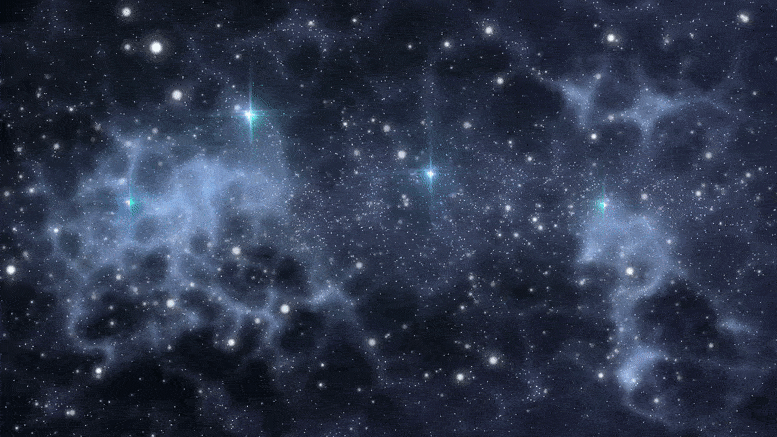Según una nueva investigación, un «mundo espejo» invisible de partículas que interactúan con nuestro mundo solo a través de la gravedad puede ser la clave para resolver el problema de la constante de Hubble.
Según una nueva investigación, un «mundo espejo» invisible de partículas que interactúan con nuestro mundo solo a través de la gravedad puede ser la clave para resolver un gran misterio en la cosmología actual: Problema de la constante de Hubble.
Él constante de Hubble Es la tasa actual de expansión del universo. Las predicciones de esta tasa, del modelo estándar de cosmología, son notablemente más lento De la tasa, nuestras mediciones locales han encontrado las más precisas. Esto es increíble inconsistencia inconsistencia inconsistencia Ella es una de las muchas cosmólogas tratando de resolverlo Cambiando nuestro modelo cosmológico actual. El desafío es hacer esto sin estropear el acuerdo entre las predicciones del modelo estándar y muchos otros fenómenos cósmicos, como el fondo cósmico de microondas. Determinar si existe tal escenario cósmico es una cuestión en la que han estado trabajando investigadores, incluidos Francis Jan Sir Racine, profesor asociado del Departamento de Física y Astronomía de la Universidad de Nuevo México, VJ, y Lloyd Knox de la Universidad de California, Davis. contestar.
cosmología Es el estudio científico de las propiedades a gran escala del universo como un todo. Busca utilizar el método científico para comprender el origen, la evolución y el destino final de todo el universo. Como cualquier campo de la ciencia, la cosmología involucra la formación de teorías o hipótesis sobre el universo que hacen predicciones específicas de fenómenos que pueden probarse a través de observaciones. Dependiendo del resultado de las observaciones, será necesario abandonar, revisar o expandir las teorías para acomodar los datos. así llamado La teoría del Big Bang Es la teoría dominante sobre el origen y la evolución del universo.
a mi[{» attribute=»»>NASA, cosmology is the scientific study of the large-scale properties of the universe as a whole. Cosmologists study concepts such as dark matter, and dark energy and whether there is one universe or many, sometimes called a multiverse. Cosmology entails the entire universe from birth to death with mysteries and intrigue at every turn.
Now, Cyr-Racine, Ge, and Knox have discovered a previously unnoticed mathematical property of cosmological models which could, in principle, allow for a faster expansion rate while hardly changing the most precisely tested other predictions of the standard cosmological model. They found that a uniform scaling of the gravitational free-fall rates and photon-electron scattering rate leaves most dimensionless cosmological observables nearly invariant.
“Basically, we point out that a lot of the observations we do in cosmology have an inherent symmetry under rescaling the universe as a whole. This might provide a way to understand why there appears to be a discrepancy between different measurements of the Universe’s expansion rate.”
The research, titled “Symmetry of Cosmological Observables, a Mirror World Dark Sector, and the Hubble Constant,” was published recently in the journal Physical Review Letters.

The COBE satellite was developed by NASA’s Goddard Space Flight Center to measure the diffuse infrared and microwave radiation from the early universe to the limits set by our astrophysical environment. Credit: NASA
This result opens a new approach to reconciling cosmic microwave background and large-scale structure observations with high values of the Hubble constant H0: Find a cosmological model in which the scaling transformation can be realized without violating any measurements of quantities not protected by the symmetry. This work has opened a new path toward resolving what has proved to be a challenging problem. Further model building might bring consistency with the two constraints not yet satisfied: the inferred primordial abundances of deuterium and helium.
If the universe is somehow exploiting this symmetry researchers are led to an extremely interesting conclusion: that there exists a mirror universe very similar to ours but invisible to us except through gravitational impact on our world. Such “mirror world” dark sector would allow for an effective scaling of the gravitational free-fall rates while respecting the precisely measured mean photon density today.
“In practice, this scaling symmetry could only be realized by including a mirror world in the model — a parallel universe with new particles that are all copies of known particles,” said Cyr-Racine. “The mirror world idea first arose in the 1990s but has not previously been recognized as a potential solution to the Hubble constant problem.
“This might seem crazy at face value, but such mirror worlds have a large physics literature in a completely different context since they can help solve important problem in particle physics,” explains Cyr-Racine. “Our work allows us to link, for the first time, this large literature to an important problem in cosmology.”
In addition to searching for missing ingredients in our current cosmological model, researchers are also wondering whether this Hubble constant discrepancy could be caused in part by measurement errors. While it remains a possibility, it is important to note that the discrepancy has become more and more significant as higher quality data have been included in the analyses, suggesting that the data might not be at fault.
“It went from two and a half Sigma, to three, and three and a half to four Sigma. By now, we are pretty much at the five-Sigma level,” said Cyr-Racine. “That’s the key number which makes this a real problem because you have two measurements of the same thing, which if you have a consistent picture of the universe should just be completely consistent with each other, but they differ by a very statistically significant amount.”
“That’s the premise here and we’ve been thinking about what could be causing that and why are these measurements discrepant? So that’s a big problem for cosmology. We just don’t seem to understand what the universe is doing today.”
Reference: “Symmetry of Cosmological Observables, a Mirror World Dark Sector, and the Hubble Constant” by Francis-Yan Cyr-Racine, Fei Ge and Lloyd Knox, 18 May 2022, Physical Review Letters.
DOI: 10.1103/PhysRevLett.128.201301

«Viajar ninja. Alborotador. Erudito del tocino. Experto en alcohol extremo. Defensor de los zombis».








More Stories
Mira cómo el Sol arrastra brevemente la cola del cometa Satán
SpaceX lanza 23 satélites Starlink desde Florida (fotos)
Puede haber una luna extra orbitando la Tierra y los científicos creen saber exactamente de dónde vino